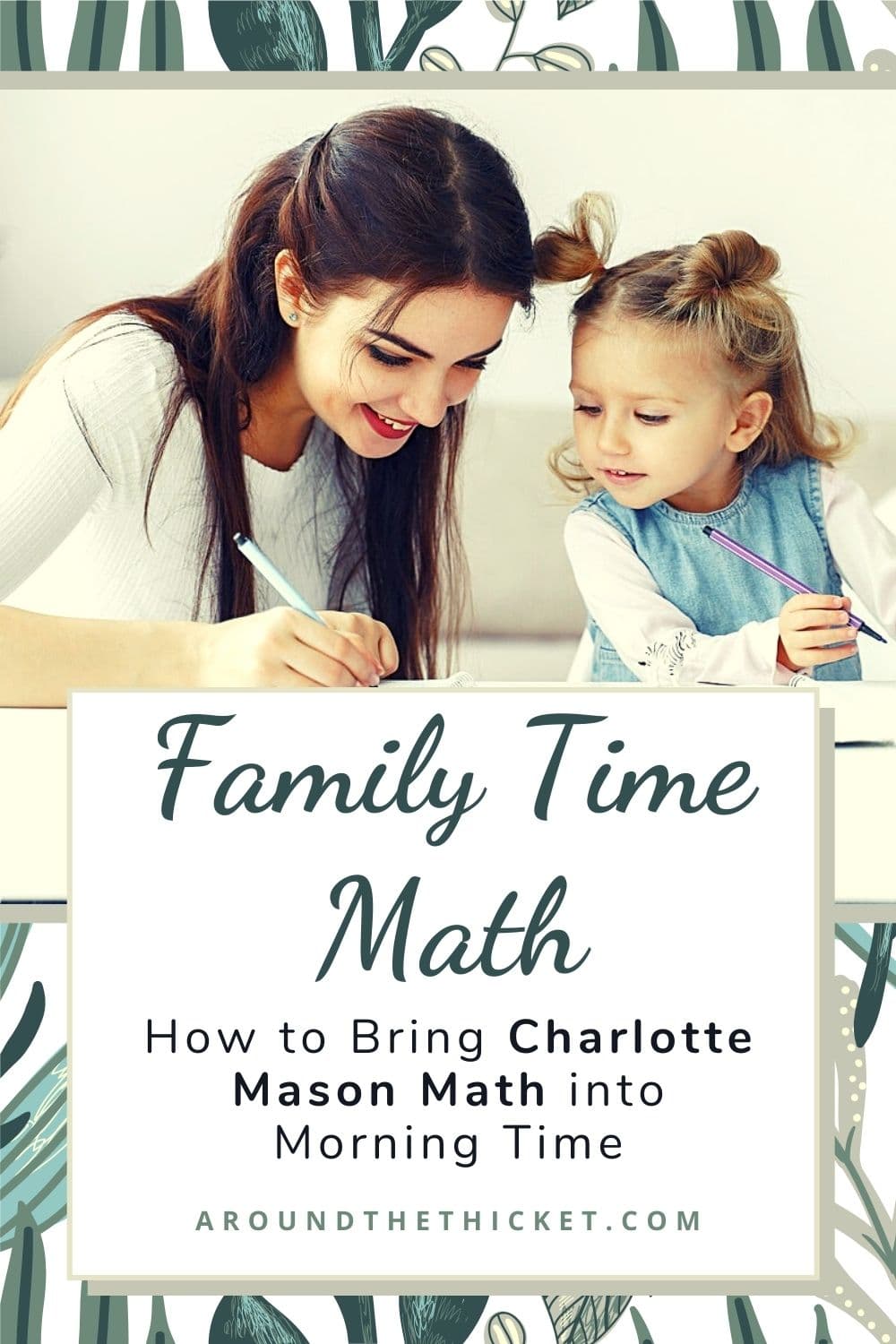How to Bring Charlotte Mason Math into Morning Time
Too often in homeschooling, math feels like a subject tacked onto a literature-rich, Charlotte Mason based curriculum. Not only can it feel dry and rote, but it can also be a solitary subject, with our kids working on their own math problems at their own pace. But while individual work might be necessary, it doesn’t have to be the whole picture. My friend (and podcast cohost) Leah Martin wanted to break math out of one-to-one instruction and weave it into family time. Based on her experience teaching with Ambleside Schools, she has created a simple curriculum to help homeschooling families add living math education into their time together.
In the conversation below, Leah and I chat about math, Charlotte Mason, and Family Time Math.
Shifting Perspectives on Living Math
Leah, we’ve chatted about math on our podcast before where we hash out Charlotte Mason’s ideas on mathematics as a part of a broad curriculum as well as how to teach it, so I’d like to start off learning more about your relationship with math. You’ve said before that as a child you thought you didn’t like math, but you’ve realized since that what you didn’t like was feeling confused and disoriented during math class. I think that’s such an important distinction! I’d love to know more about how this revelation, along with your teaching experience (both professional and homeschool) has fed into your personal ideas on how to approach teaching a child math.
I had an unsavory, but probably not uncommon, school experience growing up. Teachers and parents told me that I needed to memorize math facts, or that I need extra practice with certain skills, but they expected me, at 8 years old (9, 10, 13…) to be totally self-motivated. I didn’t have anyone sit down to help me with math or math facts- not consistently, at least. No tutors were hired, no after school meetings with the teachers were had. So, because I was a disorganized 8-year-old with little self-motivation, I quickly fell behind in math. I developed this idea that there was something wrong with me so I couldn’t do math, when really, gaps were widening and not being filled. The wider the gap, the thicker my frustration.
When I started learning about math education as a college student, I was surprised to learn that it was NOT boring or awful, and that I COULD do math. Math’s living ideas soon captured me, and as I started teaching my own class full of students, I began to recognize myself in the dazed faces of many children. They feel confused, uncomfortable, bored, but the general attitude echoes what I experienced as a child: if you don’t know it, then it’s your fault. I soon realized that attitude should be replaced with, “If you don’t know it, we need to find a better way to make it click.” This is a team effort.
I soon began searching for hands-on games and creating little jingles for math facts, hoping that presenting math ideas in a different way would slowly build a deeper understanding. Now that I’m homeschooling, I completely understand how adults became frustrated with me when I didn’t get a math concept. Often in our homeschool, I can explain something thoroughly, talk to my daughter about it, and then a moment later she doesn’t know what to do or can’t tell me anything about the skill. It didn’t happen overnight, but I had to break the pattern of getting frustrated with her when she didn’t know. Just as we talk about habit cues, any sign of misunderstanding is now my cue to present the ideas in a different way.
Establishing Math Habits
I love how your experience with math as a child has been redeemed in your teaching practice, and how it has formed your perspective in the classroom and at home teaching your daughter. I think it’s helpful that when we have a child struggling with math, we don’t label them as ‘not a math person’ or get frustrated because a concept seems so simple to us (when we’ve had decades to process, practice, and internalize it). It’s much more helpful to start looking for those gaps that haven’t clicked yet, as you put it – that concept or principle that needs a different explanation, or more practice. I think, too, sometimes our children don’t have gaps in math but have gaps in habits. My eldest son picks up new math concepts with relative ease, but he has a tendency to drag his feet around the work involved. I know that we need to do some work to build up the character to do hard things with a good attitude, and one of the blessings of homeschooling is that we can work on that together.
I’m curious about whether your thinking about math as a discipline and how to teach it have shifted both when you left public school to teach at a Charlotte Mason school, and then shifting to teaching math to your own children. I think Charlotte Mason home educators especially can either get caught up in trying to figure out and apply exactly what would have been taught in the Parents’ Review schools, or otherwise make the false assumption that Charlotte Mason is for literature and history and that we are free to grab whatever curriculum off the shelf and go to town. Thoughts?
I think you hit the nail on the head, Amy, when you said that sometimes the problem that children have with math has to do with habits and not concepts. That has been really helpful in my understanding of Charlotte Mason math. One of the biggest differences I experienced moving from public school to Ambleside School was the habit of keeping a math copybook. Notetaking is generally a good habit to get in when you’re a student, yet we rarely had time for it in public schools. That little habit allows children to process a new concept, and have a reference to look at when they need support. Since I started homeschooling, I’ve seen the importance of habits as well. My daughter tends to guess answers even though she knows what to do. We are trying to get in the habit of “doing the math,” having something written down on the paper or copybook that shows what she did to find the answer.
As far as other differences go, I am less focused on Hadley getting the right answer now. Yes, it’s important and we address it when an answer is wrong, but homeschooling means that we can talk about each problem and each concept. Knowing that she understands the ideas is more important to me at this stage. You didn’t ask this, but something that public school and Charlotte Mason had in common is that math should be hands-on. Yes, there’s a mental math component, but being able to experience something with counting chips or other math manipulatives is one of the most effective ways for a child to learn math. Children ages 7-11 (roughly) are in what Piaget called the Concrete Operational stage of development. That means that even though their logical thinking is developing, most of their thinking dwells on what they can see. So, any time we struggle with a math skill, we get a hands-on lesson going. For place value, that looked like cards that show the expanded form of a number, and then ordering those cards to make a large number. For addition and subtraction, we used snap cubes.
I think this question is interesting because I actually used the same math curriculum in public school as they do at Ambleside School and that I use at home!
Collaborative Learning in Homeschool Math
That’s funny! I think I had in mind that we could have the impression that all math curricula are created equal when, really, there are some differences that will absolutely matter! It sounds like you’re working with a great one, given that you have used it in different schools, and then chose to use it at home, too. I think this is a great time to ask you about the Family Time Math curriculum you’ve put together. Math can sometimes feel like a ‘tick box’ exercise. Our child does the lesson, gets the worksheet finished, we check the answers, and we’re done. It gets crossed off the list and we can move on with our day, maybe with a sigh of relief (depending on how you feel about math).
It strikes me, though, that you felt something was missing or could be added to your family’s math learning, despite using a solid math curriculum that has been working well. What was your initial inspiration for developing a resource to incorporate more math into the homeschool day in general, and into a family time/morning time specifically?
My inspiration for Family Time Math came from Ambleside Schools. Every day when I taught 4th grade there, we did a math warm-up that featured mental math practice. The children answered story problems, did mental computations, and also skip-counted collaboratively. There were a few times when Hadley’s math curriculum asked her to practice math facts and the practice was so boring that I found myself thinking, “I wish I could use the mental math warm-up that we had at Ambleside!” This thought sat with me for more than a year, and the more I thought about it, the more I realized that I could create something similar, but that would promote mental math practice and collaboration in the family setting.
Collaboration is one of the biggest advantages that a school setting has over a homeschool setting in the area of math. In schools, children can discuss the ideas presented in math, or they can work together to solve problems. At home, though, each child does their own math curriculum separately, and math is never a common area of conversation. I knew that by making this curriculum, it could help bring families together over math. Older children could explain ideas to younger children, and younger children could talk things out with the help of their older siblings. In order to do that, I created three levels of mental math practice that somewhat mirror each other, presenting questions that are developmentally appropriate to each level. When a family sits down with Family Time Math, they can work through similar problems together and use conversation as a tool for math learning. I’ve also included math activities that are fun for the whole family. Each activity has tasks or questions for the different levels, so that everyone is encouraged to participate and learn math ideas together. But more importantly, the whole family is making memories around math so that it’s an area that is seen as valuable and exciting rather than as drudgery.
That’s beautiful, Leah, and you’ve created a great resource. You’ve motivated me to move math revision into our morning time schedule and it’s going great for us. Thank you!
Be sure to check out Leah’s Family Time Math at My Little Robins or read a full review at My Cup Runs Over!
Want to find your feet with the Charlotte Mason Way?

Grab my eight day mini course on the Charlotte Mason Essentials when you subscribe to my newsletter. You’ll get daily emails, a mini podcast series, and a printable workbook with reading assignments and action steps. You’ll be on your Charlotte Mason journey in no time!






